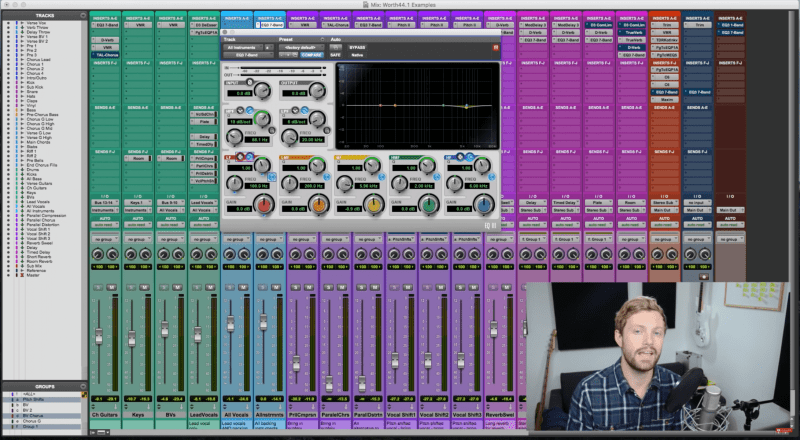This isn’t technically an EQ problem…
In fact, thin mixes usually come from a poor arrangement.
But sometimes they can come from a poor use of EQ, too.
When you prevent and address thinness in your track, you can produce a mix that’s more powerful and impactful.
You never want an important chorus to sound thin – the music will lose it’s impact.
In part 4 of the One Month EQ Challenge, I’m going to explain why your mixes sound thin.
I’m going to reveal the common EQ mistake that people make that can lead to thin mixes. You see, a lot of people have been lying to you…
Then I’m going to tell you, step-by-step, how to fix a thin mix in any genre.
This is a problem that’s not completely related to EQ; it’s a problem that a lot of the time is caused by the misuse of EQ. That’s a big cause, but actually it’s fixed by either avoiding those causes related to EQ, but mostly something that we’ve spoken about a lot in this series so far: arrangement.
First of all let’s talk about what a thin mix is to me. When people ask me how they can fix a thin mix, I’ve found that generally what they’re referring to is one of two things. First of all it could be that the bottom end, the low end in their mix is lacking, so their mix sounds thin. If you play it on a larger speaker system, it doesn’t sound good because there’s no low end or the low end isn’t tight, the low end isn’t loud enough, or it’s just not there.
Another thing that sometimes people call a thin mix is a really sparse mix. If there’s not much instrumentation, if there’s not a lot going on and there’s lots of space in the mix, it can start to sound a bit thin. Even if it had a massive bass part, if it was just a bass part and a single melody, that’s probably going to sound like quite a thin mix.
I’m going to address those two things separately. First of all let’s talk about the first thing, which is a lack of low end.
There’s two ways you can prevent this. First of all, I find the biggest reason people have a thin mix is because they get obsessed with high pass filtering. There’s a lot of people out there that give quite bad advice in the sense they tell people to high pass filter absolutely everything.
High pass filter is just when you go in your EQ and you cut out all the low end like this. Now, there are situations where that is helpful, and when you don’t need the low end, get rid of it. That’s kind of how I like to summarize it. If you don’t need it, get rid of it.
This applies to bass instruments too. If you’re working on a track and the kick is more responsible for the sub-bass, and the bass guitar is more responsible for the bass maybe between 50 and 200 hertz, then cut out everything below 50 on the bass. That’s going to tighten it up. Even with the sub, put a high pass filter at 30 or 20 hertz, again just to clean it up.
But you’re only cutting out the low end that you don’t need. If you start applying a high pass filter to absolutely everything and being really aggressive with it, you’re going to lose all the warmth, and the low end of the mix is going to start to sound thin.
So just be careful with high pass filters. Remove the low end if you don’t need it. On a vocal, again, I’ll remove everything below 60 hertz – usually higher, because it tightness up the bottom end. But then on an acoustic guitar, if it’s playing a lead part, then you probably want the low end. If it’s supportive, get rid of the low end. Just think about it. Don’t use a high pass filter on everything; only use it if you actually want to get rid of the low end or it’s causing a problem. So that’s one way you can prevent it.
The second way is through arrangement. If you’re writing a piece, think about how the low end is going to sound. Think about the relationship between bass parts to melodic parts and rhythmic parts within the piece. Because if there’s no bass part, it’s probably going to sound thin again.
Even the White Stripes, Jack White, a lot of the time of course it is just guitar and drums, but a lot of the time he does use a pitch shifter to add in a bass part. Because otherwise, a lot of the mixes sound thin. I’m not a huge fan, because I think most of their songs sound thin. I’m a bassist as well, so that’s probably why. But just to give you an example there. Think about the low end.
If it’s a more electronic piece, you actually need to think about what’s providing the sub-bass, what’s going to provide the bass, whether that’s going to be the kick or a sine wave synth just really low.
And if you’re producing rock music, of course, just put a bass guitar in there, but make sure they’re playing lower on the guitar. If they’re playing on the high octaves, it’s probably going to sound thin. Of course, it all depends, but think about the arrangement.
Now, how do you fix a thin mix? If you’ve composed the piece, you’ve recorded a piece, and it comes out thin, how do you fix that?
Well, again, you just need to address the arrangement. The way you go about that is going to depend mostly on the genre.
If you’re working with rock music and you’ve got a bass guitar in there, but the tone isn’t right – maybe you cut the bass too much on the amp, or the bass just doesn’t sound good, maybe the tone of the bass itself you’re not happy with – so the mix comes out sounding a bit thin.
With rock, you’ve got two options. If it’s modern, more alternative rock, you could use a sample that provides more low end to the kick bass, or you could just use a sine wave and gate it to the kick bass so that every time the kick hits, the sine wave comes on at like 50 hertz. That’s a good trick just to add some low end.
If you’ve got RBass or a plugin like that, RBass is a plugin from Waves that just creates new frequencies. Because it’s important to note that you can’t fix this by boosting the low end. Generally that’s not going to sound great. It depends how you go about it. If you use multiband compression or parallel compression, it can be a bit more convincing. But something like RBass, what it actually does, it creates new frequencies. You’re not just boosting what’s not there; you’re actually creating new frequencies, and this adds in more low end. So something like RBass works well for that.
If you’re working with older styles of rock where maybe samples wouldn’t work – kick samples, that is – and you don’t want too much sub-bass, then you’re going to have to rely on a plugin like RBass and just tune it a bit so it’s a bit higher.
Or with multiband compression, you can just really heavily compress the low end, maybe between 50 and 150 hertz, and leave everything else uncompressed. That should give you more of a constant, solid base to the track.
Now, for electronic music, you need to think about just adding in parts. Add in, again, a sine on a kick or a good sub-kick sample, or you could add in a constant sine wave synth just as a sub, like a tune synth with just a sine wave, and that’s going to provide a really nice low end.
This track I’ve got here is kind of electronic. It uses electronic drums. It has got guitars, but it’s mostly bass guitar and electronic piano, so it’s kind of an electronic track. Let’s have a listen with everything in first.
Now let’s listen to that kick. You’ll see I’ve got two here. I’ve got kick and sub-kick. The kick on its own is just a sample, but it’s more of an acoustic kick sound. Just to bring it a bit more low end and give it a bit more thickness, I’ve also got a sub-kick, which is very electronic-sounding. Depending on what you listen on, you might not be able to hear it that well, if you’re listening on a phone or a laptop. Together, it sounds like this. That just provides more of the sub-bass, a bit more low end to the track.
Equally, in the chorus, I’ve got a bass guitar. But then I’ve got a sub-bass part as well that’s on a synth. And together. That only comes in on the chorus; it gives the chorus some nice thickness, if you have a listen to that.
So just think about arrangement. Think about new parts you could add in in that sub-bass or bass area that could make your mix sound less thin.
Two more genres worth mentioning. If it’s hip-hop, focus more on the kick and providing a really good kick sample with lots of sub-bass. If it’s pop, then it purely depends on the kind of pop it is. If it leans more toward the electronic side, think more about sub-kicks, sine synths, and really low constant synths or other ways you could provide bass. Or if it’s a rockier pop track, then think more about multiband compression, RBass, and maybe kick samples as well.
If it’s a sparse mix, which is the other problem that sometimes people are referring to when they say their mix is thin, then you’ve got a different problem. You could have a sub-bass part, you could have a bass part, it could be a really thick, full mix – yet if it’s only two instruments or two parts, it’s going to sound quite thin.
That’s where effects and automation really come into it. Because you’ve got so much space in the mix, you can afford to be more liberal with your use of reverb, your use of delays, your use of creative automation, and various other effects.
Just to summarize now, thinness comes from normally an arrangement problem, as with most things regarding EQ. Try and fix it by introducing new parts, but also try to avoid using high pass filters, because that’s a big cause of thin mixes, when you start really high pass filtering everything too much or cutting too much low end out of absolutely everything. Your mix is going to start to sound thin.
You can introduce new parts depending on the genre. For rock, try samples as well as multiband compression, plugins like RBass. Electronic, think about samples and low sine synths. For hip-hop, samples. Pop, it depends what kind of pop it is. And if it’s a sparse mix, try to use effects to fill it out a bit.













